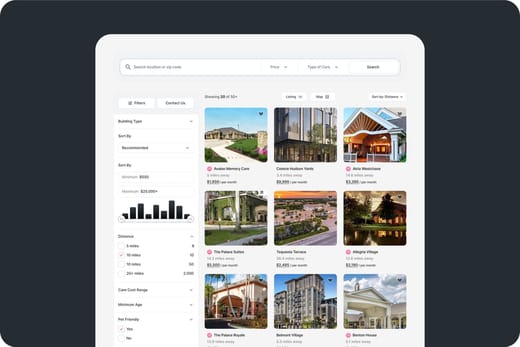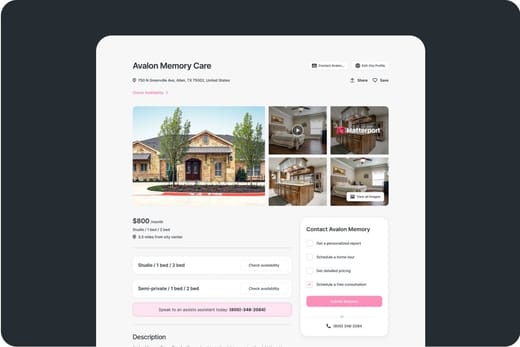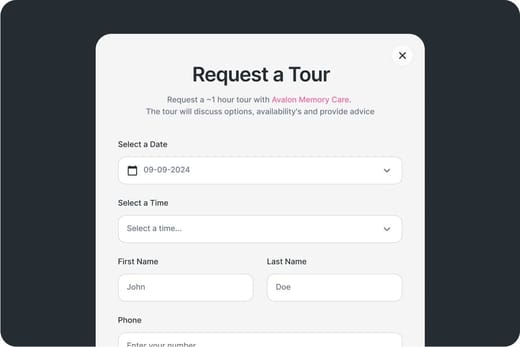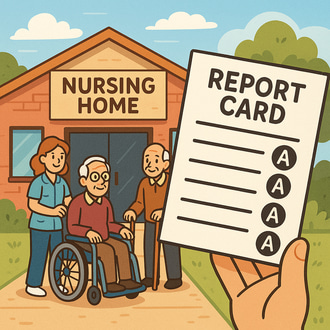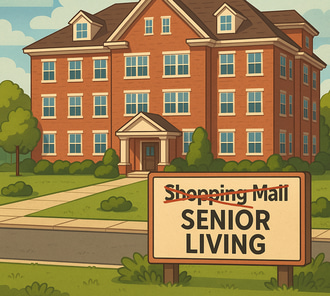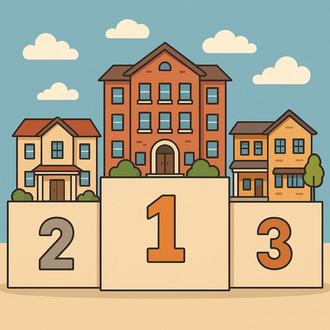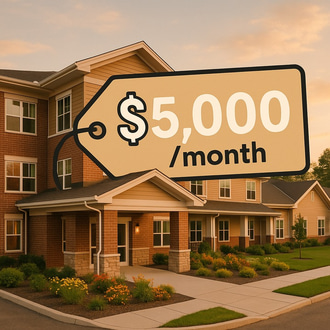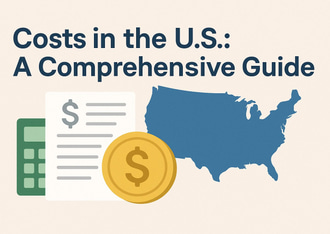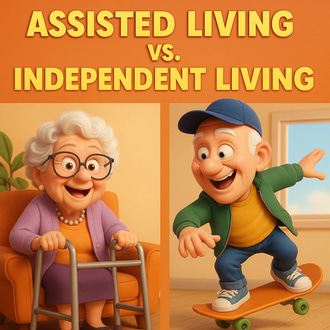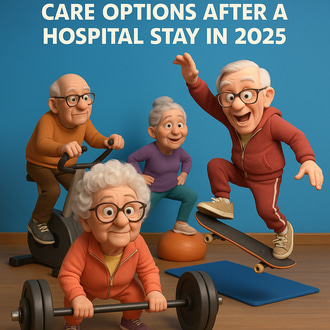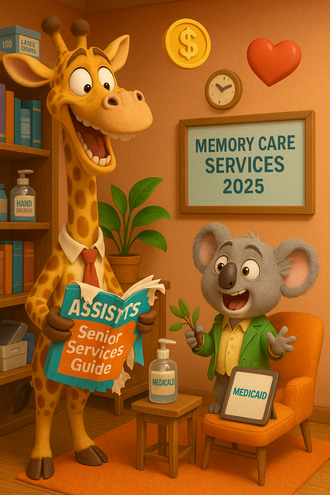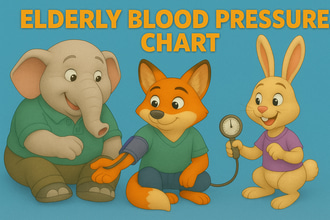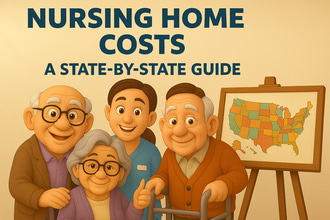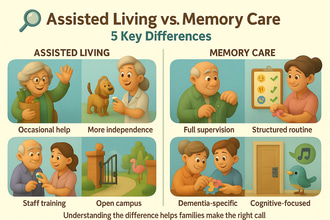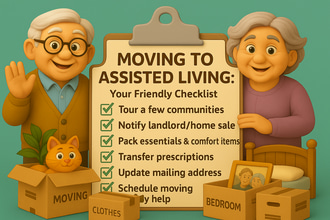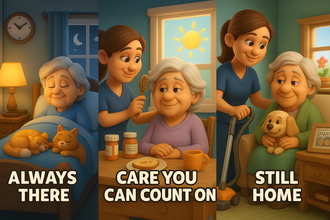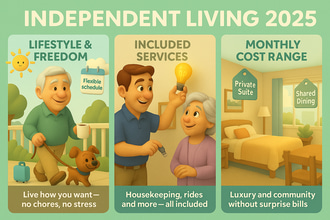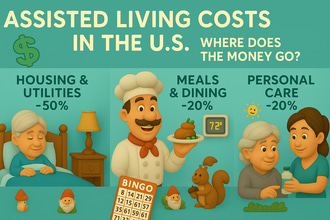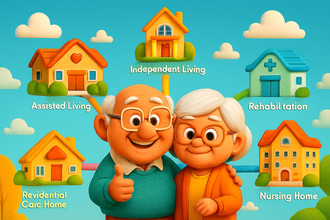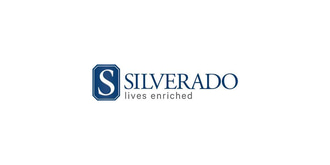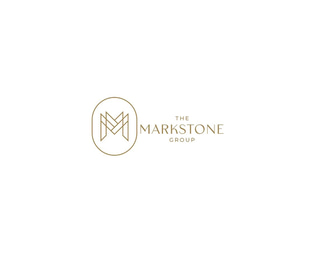When researching retirement homes, the first number you see — assisted living averaging $5,900 per month and independent living around $3,000 — can feel overwhelming.
But the sticker price rarely tells the whole story. These communities use different pricing models and offer discounts that aren’t always advertised. Beyond that, various financial assistance programs exist to help offset costs. Understanding how these work can significantly reduce what you pay while still ensuring quality care.
Understanding Pricing Models
Pricing models vary across senior living communities. They affect not only your monthly bill, but also how predictable your costs will be over time.
Here’s how the three main models work:
À La Carte (Fee-for-Service)
Pay a base monthly rent that covers your apartment and basic services. Everything else — personal care assistance, medication management, specialized therapies — you add as needed.
Here are some pros and cons to consider with the à la carte model:
| Pros | Cons |
| Only pay for services you use | Costs become unpredictable as needs increase |
| Lower initial monthly rate | Can be more expensive than all-inclusive |
| Maximum flexibility and control | Requires careful tracking of expenses |
Pro tip: Ask for a detailed breakdown of what’s included in the base rate. Communities that charge extra for amenities like cable TV or transportation can add hundreds of dollars to your monthly costs.
All-Inclusive
A flat monthly fee covers everything — rent, meals, utilities, housekeeping, and most care services. You know exactly what you’ll pay each month, making financial planning straightforward.
Here are some pros and cons to consider with the all-inclusive model:
| Pros | Cons |
| Predictable monthly costs, no surprise bills | Higher upfront monthly rate |
| No need to track individual service charges | May pay for services you don’t currently need |
| Rate stays stable even as you use more services | “All-inclusive” varies by community |
Pro tip: Get a written list of what’s actually covered. Some communities exclude incontinence care, salon services, or private transportation from their “all-inclusive” rate.
Tiered Pricing
Communities assess your care needs and assign you a pricing tier. As your needs increase, you move to a higher tier with a higher monthly rate. Reassessments usually happen when staff notice changes in your abilities or when family requests them.
For example, someone who needs help with bathing and medication management might be in Tier 2, while someone requiring memory care support or 24-hour supervision could be in Tier 3 or 4.
Here are some pros and cons to consider with the tiered pricing model:
| Pros | Cons |
| Pay for your current level of care, not future needs | Monthly costs increase as tiers change |
| Ability to age in place as needs change | Frequency of assessments affects cost predictability |
| Fair pricing that matches care received | Large jumps between tiers in some communities |
Pro tip: Ask to see pricing for all tiers upfront. Some communities have dramatic increases — Tier 1 at $4,000 monthly versus Tier 3 at $6,500. Others have more gradual changes that are easier to budget for.
Choosing the Right Model
Your best fit depends on your current needs and how you prefer to handle financial planning:
- À la carte works if you’re independent now and want maximum flexibility.
- All-inclusive makes sense if you value predictability and don’t want to track individual charges.
- Tiered pricing is ideal if you want to age in place with costs that scale as your care needs actually change.
Finding Discounts and Special Offers
Some senior living communities offer discounts that can lower your monthly rate. Move-in specials, seasonal promotions, and membership benefits are common.
Here’s what to know about each:
Move-In Specials
Communities often run limited-time promotions to fill vacant units. These can include waived application fees, one month of free rent, or a reduced deposit or community fee.
The savings can be meaningful, provided you can meet certain conditions. You’ll typically need to move in by a specific date, pay a non-refundable deposit, or commit to a minimum stay period.
For example, The Watermark at Rosewood Gardens in Livermore, California, offered one month of free assisted living rent for residents who moved in by July 31, 2025. And at the time of writing (October 2025), Sonrisa Senior Living in Roseville, California, is promoting a savings of $1,000 on monthly rent plus a 50% savings on the one-time community fee.
Pro tip: Don’t let the urgency of a deadline push you into a community that doesn’t meet your needs. A generous discount isn’t worth it if you’re unhappy and looking to move again within a year.
Holiday and Seasonal Offers
Communities offer stronger promotions during slower seasons — typically late fall and winter — when occupancy rates drop. Holiday periods (e.g., Thanksgiving, Christmas) also bring special deals, often timed when families visit and help with decision-making.
You might see these promotions:
- Reduced rates for a set period
- Special amenity packages
- Enhanced services at no extra cost
Many communities also run referral programs. If a current resident refers you, both of you may receive a bonus — often a rent credit or reduced fees. If you know someone already living in a community you’re considering, ask if a referral program exists before you apply.
Pro tip: If you’re flexible on when you move, track promotions at your top-choice communities over a few months rather than jumping on the first discount you see. Having a shortlist of two or three communities and checking their offers monthly puts you in a better position to spot genuine value.
Membership-Based Savings
It pays to be a member of senior-related organizations that provide benefits and discounts.
For example, a $15 to $79 membership fee to the American Association of Retired Persons (AARP) can get older adults discounts on the following:
- Dining
- Travel
- Car rentals
- Cruises
- Flights
- Health and wellness products
While these don’t directly reduce monthly senior living costs, they can lower overall expenses — allowing you to enjoy retirement.
Pro tip: Some senior living communities also offer discounts to members of specific organizations. When touring communities, ask if they partner with any membership group for reduced rates or waived fees. The savings might be modest — like a few hundred dollars off an entrance fee — but combined with other discounts, they add up.
Financial Assistance Programs
Several programs can help cover senior living costs, depending on your situation:
Medicaid
Medicaid is a state and federal program that provides healthcare coverage for low-income individuals. When it comes to senior living, coverage varies by state.
For assisted living, waivers can cover certain services, such as personal care, medication management, and healthcare-related assistance. However, room and board costs are rarely covered. This means you’ll still need to pay for your apartment, meals, and basic living expenses out of pocket.
Nursing home care is where the program offers full coverage for eligible individuals, including room, board, and medical services. This makes it a more comprehensive option if you need skilled nursing care rather than assisted living.
Each state has different income and asset limits for eligibility. If you’re considering assisted living, confirm that the community accepts Medicaid waivers before moving in — not all facilities participate, and those that do may have limited Medicaid beds available.
Medicare
Medicare is the federal health insurance program for individuals 65 and up. Unlike Medicaid, it’s not based on income. Most people who paid Medicare taxes while working are eligible.
When it comes to senior living costs, Medicare has limited coverage. It covers short-term skilled nursing or rehabilitation care for up to 100 days, but only after a qualifying hospital stay of at least three days. This is designed for recovery, not long-term assisted living or custodial care.
Medicare doesn’t cover the monthly costs of assisted living or independent living communities. Room, board, and personal care assistance aren’t considered medical necessities under Medicare guidelines. So, you’ll need to pay for these out of pocket or through other programs.
Veterans Benefits
If you’re a veteran or surviving spouse, several options can reduce senior living costs. The primary resource is the U.S. Department of Veterans Affairs’ Aid and Attendance benefit, which provides monthly financial assistance. Additionally, veterans have access to specialized housing options and community discounts.
Aid and Attendance Benefit
This program offers tax-free monthly payments based on your situation.
Here are the 2025 rates:
- Single veteran: $2,358 per month
- Married veteran: $2,795 per month
- Surviving spouse: $1,515 per month
To qualify, you need at least 90 days of active duty service with at least one day during a wartime period, an honorable discharge, and demonstrated need for assistance with daily activities. Income and asset limits also apply.
Community Discounts
Some senior living communities offer special rates for veterans and surviving spouses. For example, Ciel Senior Living offers $150 off monthly rent for eligible veterans.
Armed Forces Retirement Homes (AFRH)
These provide veterans and surviving spouses with assisted living options at lower costs than private communities.
Military-Only Senior Living Communities
Often operated by non-profit organizations, these facilities offer veterans and surviving spouses relatively affordable rates in communities designed for military families.
VA Home Loans
For veterans and service members, VA home loans offer favorable terms, including no down payment, no private mortgage insurance, and limited closing costs.
HUD Programs
The U.S. Department of Housing and Urban Development (HUD) offers subsidized housing options for low-income seniors. These programs can make independent living and some assisted living communities more affordable by reducing rent based on your income.
Some retirement communities also offer their own subsidies for low-income residents. These may come through congregate care housing, local housing agencies, or HUD funding. Eligibility requirements vary by community and program, but generally target seniors with limited income and assets.
To find subsidized senior housing in your area, start with HUD’s website or contact your local Area Agency on Aging. Wait lists for subsidized housing can be long — sometimes years — so apply early if you think you’ll need this assistance.
Other Aid Programs
While not specific to senior living costs, these federal programs can help reduce your living expenses:
- Supplemental Nutrition Assistance Program (SNAP): Monthly financial assistance for food purchases
- Low-Income Home Energy Assistance Program (LIHEAP): Help with home heating and cooling costs
- Weatherization Assistance Program: Assistance with energy bills of over $300 annually
Moving Forward
Senior living doesn’t have to stretch your budget beyond what’s sustainable.
Approach this decision like any major financial commitment. Do your research, compare your options, and don’t assume the advertised rate is final. Communities have more flexibility than their websites suggest, and programs exist to help cover these costs.
Finding the best value comes down to asking questions, timing your decisions strategically, and understanding what financial tools are available to you.
Frequently Asked Questions (FAQs)
Can I negotiate senior living home prices?
Yes, many communities have flexibility on pricing, especially if they have vacant units or you’re ready to move in quickly. Ask about current promotions, flexibility on entrance fees, or whether they can match rates from comparable communities. The advertised rate is often a starting point, not the final price.
Which senior living home pricing model saves the most money?
À la carte is usually cheapest if you stay relatively independent. But if your needs increase, all-inclusive may become more cost-effective since your rate stays stable. Tiered pricing falls in the middle, adjusting costs as your needs change without the unpredictability of à la carte or the higher upfront cost of all-inclusive.
What’s the difference between Medicare and Medicaid for senior living?
Medicare is federal health insurance for people 65 and older, and covers short-term skilled nursing after hospitalization — not ongoing assisted living costs. Medicaid is a state-federal program for low-income individuals that can cover some assisted living services and nursing home care for eligible seniors. Most people funding senior living long-term will need resources beyond Medicare.

